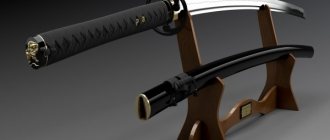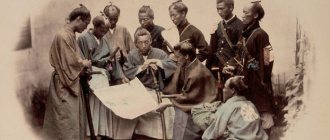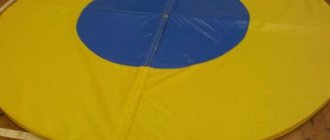Kimono
The kimono is considered traditional Japanese clothing, which since the 18th century has also been considered the national costume of Japan. Kimono is available for men and women. This is a T-shaped robe that can have different lengths. The robe does not have fasteners or buttons, but is fastened with an obi belt, which is located at the waist. European buttons in the Japanese kimono are replaced by straps or strings. This type of Japanese clothing has sobe sleeves, which are wide.
Harakiri
Harakiri
Ritual suicide by cutting open the abdomen - seppuku or harakiri - is an immediate attribute of the samurai. Seppuku was committed at a time when the samurai was unable to follow the code of bushido, or when he was captured by an enemy. Ritual suicide was not only done voluntarily, but was also used as punishment, but in any case it was an honorable way to die.
The ritual of seppuku is a fairly lengthy ritual. It began with a washing ceremony. After bathing, the warrior was dressed in all white and brought his favorite food. Immediately after eating, a short sword was placed on the already empty dish. Next, the samurai wrote a dying poem - tanka (a five-line Japanese poetic form consisting of 31 syllables). After this, the samurai took a short sword, wrapped the blade in cloth so as not to cut his hand, and committed suicide by cutting his stomach.
The person nearby had to finish off the samurai by cutting off his head. In most cases it was the closest friend who was given the greatest honor and was given an honorable role. The assistant's greatest skill was to cut off the head so that it hung on a small strip of skin and remained in the arms of the already dead samurai.
Types of masks
The mask was removable; most often it was removed during battle, as it blocked the view. The general term for any mask is men-gu. There are five types of mengu in total, differing in the types of facial protection.
- Happuri;
This type of mask was a metal plate that protected the forehead, cheeks and temples. Very often, khappuri was used by servants as full-fledged helmets. It was also worn by infantrymen. The throat protection was not attached to this mask.
- Hambo;
The most important advantage of such a mask is its ease of wearing. It covered only the chin and neck. The view in such a mask was completely open, so it was in great demand. Hambo is considered a half mask.
- Mempo;
This half mask covered almost the entire face, except for the area around the eyes. Mempo was designed in such a way that the plate located on the nose could be easily removed. But this was practiced extremely rarely. The mask had a rather expressive grimace, which was expressed in a fighting grin, the presence of a mustache and sideburns.
- Somen;
This type of mask appeared during the reign of Muromachi. It completely covered the face, which is why somen did not gain as much popularity as other men-gu.
- Bamen;
This type of mask protected not a human head, but a horse head. The first appearance of the bamen dates back to the seventeenth century. This mask was made from boiled and patent leather. Additionally, the mask was decorated with fangs and horns, which made the animal look like a mythical creature.
Many historians believe that the Japanese tradition of making armor from plates appeared as a result of the influence of European countries. This has not been established exactly, so this topic is the subject of debate, however, in Japan, armor was created based on the prototype of European armor. This armor was called nanban - do, which translates as “armor of the southern barbarians.”
Specialists who created armor were valued almost as highly as gunsmiths. The names of the most famous craftsmen of that time have been preserved in history - this is the Myotia family, which has been creating armor since the 13th century. With each new century, the style of the masters changed. During brutal wars, no special attention was paid to decorations; the main attributes were the strength of the material from which the armor was made. The armor created during that period is considered a work of military and jewelry art.
Story
The Nara period (710-794) was characterized by strong Chinese and Buddhist influence. During the Heian period (794-1192), ties with China weakened and Japanese culture as we know it was formed. The kimono of this time had many layers and was very heavy. The ladies of the court wore kimonos made of 12 layers of fabric! Each of them was combined in color with the others, creating an exquisite ensemble. There were hundreds of rules for combining colors and wearing a kimono.
The Kamakura (1192-1338) and Muromachi (1392-1573) periods - during this time, kimono began to be worn without hakama and began to be tied with an obi belt. Kimonos took on bright colors.
The Edo period (1603-1867) was a time of economic growth and urban development. At this time, kimono sleeves became longer, especially for young unmarried girls. Obi became wider and acquired many variations in color and shape. Samurai wore kimonos on a regular basis. The color and pattern of a samurai's kimono were determined by the clan to which he belonged. High demand created a new kimono market, where craftsmen could already boast of incredible skill and sophistication. The kimono of this period became the basis of the current form of national clothing.
The Meiji period (1868-1912) was a time of innovation and Western influence. At this time, the kimono ceased to be so popular for everyday wear. The clothing of police officers, teachers and railway workers, and school uniforms switched to Western style. Ordinary residents wore kimonos with family crests. Men began to wear business suits more often instead of kimonos. Kimono production has become acquainted with Western technologies, and buying a high-quality silk kimono has become significantly cheaper.
The Taisho period (1912-1926) was a leap forward for Japanese industry. People moved to the city in droves, women got more jobs and started wearing Western clothes to work. But the kimono did not disappear from view, but acquired new trends. New unusual kimonos have appeared in the Western art deco style.
The Showa period (1926-1989) was a turning point for Japanese history and Japanese fashion. After the war, most of the country's inhabitants switched to Western clothing, and kimonos were worn mainly by older generations and geishas. The kimono became a more ceremonial garment and rules were formed regarding which kimono corresponds to which event. For the country after the crisis, a real kimono became a luxury and not everyone could afford it.
Currently, the kimono is experiencing a revival. The culture of wearing kimono is no longer limited to special occasions and girls can be seen wearing traditional clothing on the streets. New technologies have made production easy and provided a huge variety of fabrics, colors and patterns. Rarely is a wedding complete without a beautiful traditional kimono. Photo shoots in kimonos are very popular among both Japanese and tourists.











